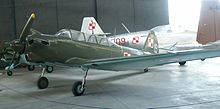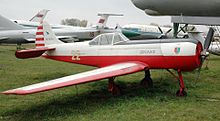Yakovlev Yak-18
The Jakowlew Jak-18 ( Russian Яковлев Як-18 ) is a Soviet two-seat trainer aircraft .
history
As early as 1943, tests were carried out with a modified UT-2 (UT-2MW), the successor of which was to be the Jak-18. In contrast to the UT-2, the Jak-18 had a retractable landing gear and landing flaps. The UT-2L (also Ja-19) was tested in 1945/46 and can be seen as the initial model of the Jak-18. The state flight tests were completed in 1947 and shortly afterwards series production of the first version, which was still equipped with a tail wheel chassis, began.
The Jak-18 versions were given the NATO code name "Max".
Versions
- Jak-18 - First production version from 1947 with a 160 HP M-11FR star engine. Series production from 1947 to 1953 at the Kharkov state aircraft factory.
- Jak-18U - Second series version, built in series from 1954/55. She had a nose wheel landing gear and an elongated fuselage. 5680 pieces of the Jak-18 and Jak-18U were produced.
- Jak-18A (also Jak-20) - From 1957 the Jak-18A was tested. It was the first version with the 260 hp radial engine Ivchenko AI-14R and an adjustable propeller (W-530 series). By the end of production in 1967, 950 copies had been produced.
- Jak-18P - With the Jak-18P, a fully aerobatic single-seat starter trainer was created in 1960.
- Jak-18PM - The Jak-18PM was a largely revised single-seat aerobatic version. The cockpit was moved back, the V-position of the wings decreased and the ailerons enlarged. In the 1960s, it was one of the most popular aircraft for acrobatics. The engine used was the AI-14RF, which had a takeoff power of around 300 hp.
- Jak-18PS - The cell largely corresponds to the Jak-18PM, but was equipped with a rear landing gear. The main landing gear was retractable.
- Jak-18T - The cabin of the Jak-18T has been completely redesigned. In it, the pilot and a passenger sat next to each other and two other passengers in the back seat. It flew for the first time in 1967 and was presented for the first time that same year at the Aérosalon in Le Bourget . The start of production dragged on until 1973. After production ceased in 1982, Technoavia built another 50 units in 1993/94. The four-seat Jak-18T is mainly used in Eastern Europe as a training aircraft, light transporter and for checking pipelines . Originally, the purpose was to act as an initial trainer for flight students at Aeroflot . The at that time atypical use of control horns shows a requirement for this purpose at that time. The Jak-18T is suitable for aerobatics and IFR, also powered by an AI-14RF.
- Nanchang CJ-5 - Chinese license builds.
- Nanchang CJ-6 - Chinese further development of the CJ-5, from 1962. A not inconsiderable part of it has been redesigned, external differences are the main landing gear, which is completely retracting inwards, and the straight edges of the tail unit. A Chinese license build of the M-14, the Huosai 6A (HS-6A), served as the drive. Models from 1965 received an improved version of this engine and the designation "CJ-6A". A lightly armed variant built in small numbers was given the designation "CJ-6B". In total, over 2000 CJ-6s were built and around 200 exported.
production
Until production of the "old" versions (up to Jak-18PM / PS) was discontinued at the end of 1971, 6760 Jak-18s were built; together with the Jak-18T, production increased to around 8,000 machines. Hungary produced the Jak-18 under license from 1956. Total Chinese CJ-5 production from 1954 to 1958 totaled 379 machines. Production of the Jak-18T was resumed in 1993 in small numbers.
Military users
-
 Egypt
Egypt
-
 Afghanistan : 14 from 1957 to 2001
Afghanistan : 14 from 1957 to 2001 -
 Albania : 43 including Chinese CJ-5
Albania : 43 including Chinese CJ-5 -
 Algeria
Algeria
-
 Bangladesh
Bangladesh
-
 Bulgaria
Bulgaria
-
 People's Republic of China : Buildings under license as CJ-5
People's Republic of China : Buildings under license as CJ-5 -
 German Democratic Republic : 65 units of the original Jak-18 and Jak-18U flew from 1952 to 1972 with the KVP-Luft , the NVA and the GST
German Democratic Republic : 65 units of the original Jak-18 and Jak-18U flew from 1952 to 1972 with the KVP-Luft , the NVA and the GST
-
 Guinea
Guinea
-
 Iraq
Iraq
-
 Yemen
Yemen
-
 Cambodia
Cambodia
-
 Laos
Laos
-
 Mali
Mali
-
 Mongolia
Mongolia
-
 North Korea
North Korea
-
 Austria : 4 from 1955 to 1965
Austria : 4 from 1955 to 1965 -
 Poland
Poland
-
 Romania
Romania
-
 Zambia
Zambia
-
 Somalia
Somalia
-
 Soviet Union
Soviet Union
Technical specifications
| Parameter | Jak-18 | Jak-18U | Jak-18A (Jak-20) | Jak-18P | Jak-18PM | Jak-18T |
|---|---|---|---|---|---|---|
| Conception | School and sport aircraft | Aerobatic plane | Touring plane | |||
| Manufacturer | Kharkov Aircraft Plant, Plant No. 116 Arsenyev | |||||
| Years of construction | 1947-1953 | 1954-1955 | 1957-19 ?? | 1960-19 ?? | 1966-1971 | 1973-1982 / 1993/94 |
| number of pieces | together 5680 (without licensed buildings) | 950 | together 156 | 587 / ≈50 | ||
| crew | 1-2 | 1 | 1 + 3 passengers | |||
| length | 8.03 m | 8.13 m | 8.18 m | 8.35 m | ||
| span | 10.60 m | 11.16 m | ||||
| height | 2.18 m | 2.75 m | 2.65 m | 3.35 m | k. A. | |
| Wing area | 17.00 m² | 16.50 m² | 18.5 m² | |||
| Wing extension | 6.6 | 6.8 | 6.7 | |||
| Wing loading | 65.4 kg / m² | 68.6 kg / m² | 75.3 kg / m² | 61.7 kg / m² | k. A. | 87.5 kg / m² |
| Empty mass | 810 kg | 880 kg | 995 kg | 907 kg | k. A. | 1200 kg |
| Takeoff mass | 1112 kg | 1166 kg | 1281 kg | 1050 kg | 1100 kg | 1620 kg |
| Engine | an air-cooled 5-cylinder radial engine Schwezow M-11FR |
an air-cooled 9-cylinder radial engine Ivchenko AI-14R |
an air-cooled 9-cylinder radial engine Ivchenko AI-14RF |
|||
| Starting power | 119 kW (162 hp) | 191 kW (260 hp) | 220 kW (299 hp) | |||
| Fuel supply | 150 l | 126 l | 122 l | k. A. | k. A. | 150 l |
| Power load | 9.3 kg / kW | 9.8 kg / kW | 5.6 kg / kW | 5.5 kg / kW | 5.0 kg / kW | 7.4 kg / kW |
| Top speed close to the ground |
248 km / h | 235 km / h | 254 km / h | 300 km / h | 320 km / h | 300 km / h |
| Cruising speed | 155 km / h | 160 km / h | 175 km / h | 220 km / h | 265 km / h | 250 km / h |
| Landing speed | 85 km / h | 103 km / h | 110-115 km / h | 85 km / h | 90 km / h | k. A. |
| Climb performance | 3.5 m / s | 3.6 m / s | 5.0 m / s | 8.5 m / s | 10.0 m / s | 5.0 m / s |
| Service ceiling | 4000 m | 5000 m | ||||
| Range | 1015 km | 780 km | 725 km | 400 km | 1000 km | |
| Take-off / landing route | 290 m / 250 m | 365 m / 345 m | 210 m / 260 m | k. A. | 140 m / 130 m | 200 m / 200 m |
Museum reception
- A Jakowlew Jak-18 of the Austrian Armed Forces is on display in the military aviation exhibition Zeltweg in hangar 8 of the Hinterstoisser air base, a branch of the Vienna Army History Museum .
- A Jak-18A with the tactical number 25 (civil registration DM – WGW ) is in the Military History Museum in Berlin-Gatow .
See also
literature
- Heinz AF Schmidt: Soviet planes . Transpress , Berlin 1971, p. 164-166 .
Web links
- Greg Goebel: Yakovlev Piston Trainers & Stunters. In: www.airvectors.net. September 1, 2018, accessed April 4, 2020 .
Individual evidence
- ^ Jaks in Germany . In: Detlef Billig (Ed.): Typenschau . No. 02 . TOM-Modellbau, Friedland 2005, p. 22/23 .
- ^ Greg Goebel: Yakovlev Piston Trainers & Stunters. In: www.airvectors.net. September 1, 2018, accessed May 3, 2020 .
- ^ Wilfried Copenhagen: Planes and helicopters of the NVA from 1956 to 1970. Brandenburgisches Verlagshaus, Berlin 1990, ISBN 3-327-00547-8 , p. 38
- ^ Detlef Billig, Manfred Meyer: Airplanes of the GDR. Type book military and civil aviation. Volume I: until 1962. TOM Modellbau, Friedland, 2001, ISBN 3-613-02198-6 , pp. 84–89.
- ↑ Aircraft of the Austrian Air Force. In: http://www.doppeladler.com . Retrieved May 3, 2020 .
- ^ Heinz AF Schmidt: School and sport aircraft. In: Aerotype. , Transpress, Berlin 1969, pp. 78/79
- ^ Heinz AF Schmidt: Airplanes from all over the world. Volume III. , Transpress, Berlin, p. 103
- ^ Heinz AF Schmidt: Airplanes from all over the world. Volume III. , Transpress, Berlin, p. 104
- ↑ a b c Ulrich Unger: For the 75th birthday of AS Jakowlew - his sport and training aircraft . In: Fliegerrevue . No. 2/1981 (336) , pp. 71 .
- ↑ Teaching Collection: Military Aviation Yesterday - Today - Tomorrow. In: www.doppeladler.com. Retrieved May 3, 2020 .
- ^ Detlef Billig, Manfred Meyer: Airplanes of the GDR. Type book military and civil aviation. Volume II: until 1972. TOM Modellbau, Friedland, 2002, ISBN 3-613-02241-9 , p. 182.







